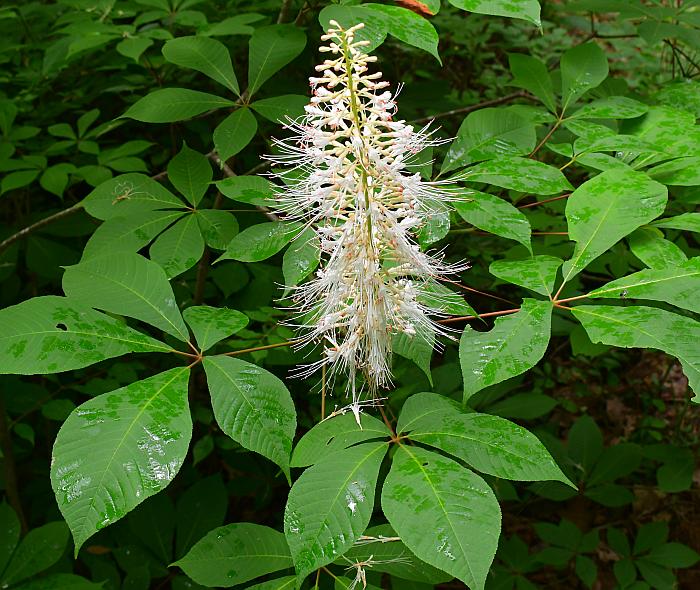Aesculus parviflora Walter
Bottlebrush Buckeye

Native
CC = n/a
CW =
MOC = 0
© SRTurner
Aesculus parviflora WalterBottlebrush Buckeye | |
 |
Native CC = n/a CW = MOC = 0 |
© SRTurner |
|
Family - Sapindaceae Habit - Shrub, strongly suckering from rhizomes. Stems - Ascending or erect, multiple from base, woody, branching, to 5 m. Young growth often reddish-green, glabrous.
Leaves - Opposite, long-petiolate, palmately compound with 5 leaflets. Leaflets oval to obovate, acute, to 10 cm long and 5 cm broad, the margins finely serrate, the upper surface glabrous or nearly so, the lower surface glabrous to moderately pubescent. Petioles reddish, glabrous to sparsely pubescent, to 15 cm long.
Inflorescences - Long terminal panicles to 30 cm. Axis sparsely pubescent. Pedicels to 7 mm long, pubescent.
Flowers - Calyx 5-lobed, creamy white. Calyx tube to 5 mm long, 2-3 mm in diameter, pubescent. Lobes subequal, 2 mm long, reddish at apex, rounded. Petals 4, equal, clawed, white, glabrous, rugose internally, to 1.6 cm long, 3-4 mm broad at apex, typically notched at apex. Stamens 6, strongly exserted. Filaments white, to 4 cm long, glabrous. Anthers red, 2.5 mm long, 1.2 mm broad. Style 6 mm long, pubescent.
Fruit - Shiny, smooth capsule, longer than broad, with 1-3 seeds. Missouri plants rarely produce fruits. Flowering - June - September. Habitat - Mesic forests. Cultivated. Origin - Native to southeastern U.S. Lookalikes - Other buckeyes, such as A. glabra. Other info. - This plant is primarily found in Alabama but is rare elsewhere, except in cultivation. In Missouri the only population reported outside of direct cultivation is at Shaw Nature Reserve, where a single colony of well-naturalized plants have continued to flourish for years. This population undoubtedly persists from a deliberate cultivation event at some point in the past. The species is a popular ornamental because of the many long, attractive panicles it produces in flower. A large colony can be a striking sight when in full flower. As with all members of the genus, its seeds are toxic. The flowers attract hummingbirds and butterflies. Photographs taken at the Kansas City Zoo, 7-10-99 and 7-13-00, in Auburn, AL., 3-6-05, and in the Red Hills of Alabama, 6-4-05; also at Shaw Nature Reserve, Franklin County, MO, 6-18-2011, 6-30-2017 and 6-30-2021 (SRTurner). |